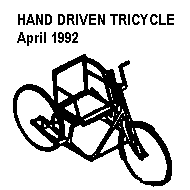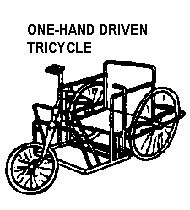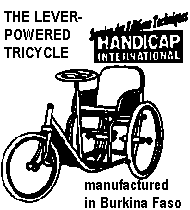Nothing About Us Without Us
Developing Innovative Technologies
For, By and With Disabled Persons
PART FOUR
WHEELS TO FREEDOM
CHAPTER 31
For Long Runs on Lousy Roads:
A Hand-Pumped Tricycle
ALEJANDRO'S CHANGING MOBILITY NEEDS

ALEJANDRO was 12 years old when he was shot through the spine by a policeman. The events surrounding this brutal incident will be briefly described in Chapter 40, page 261, under the heading, "Defense of Human Rights." Here, we will focus on Alejandro's changing mobility needs, and the equipment designed at PROJlMO to help him move about at the different stages of his rehabilitation and re-entry into community life.
Alejandro first arrived at PROJIMO two months after his injury. For a child who was completely paralyzed from the mid-back down, he was in good spirits. Although he had been told he might never walk again, he was eager to get back into action. He progressed through using 3 forms of locomotion: a gurney, a wheelchair, and a tricycle.
A GURNEY to Recover from Pressure Sores and Prevent Urinary Infections

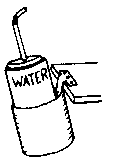
Like so many spinal-cord injured young people who come to PROJIMO, Alejandro already had deep pressure sores when he arrived. The sores had begun to form while he was in the hospital. Therefore, his first mobility aid was a wheeled cot, or gurney (see Chapter 37). This allowed him to lie on his stomach, taking pressure off the sores on his butt. In the wheelchair shop, the gurney was built to the boy's size.
At Alejandro's request, a simple rack to hold a container with drinking water was made from a plastic gallon bottle and attached to the front of the gurney. Handy access to drinking water is essential, especially in a hot climate, because one of the best ways to prevent bladder and kidney infection is to drink lots and lots of water. For Alejandro to have his own water container (with its attached plastic straw) within easy reach wherever he went, was an important (and possibly life-saving) measure.
The gurney had another feature to help prevent urinary infections: a built in free-flow urinal (see next page).
|
A catheter is a rubber or plastic tube, used to drain urine from the bladder:
|
With spinal-cord injury, the person usually loses bladder (and bowel) control. To get the urine out and prevent wetting the clothing, a catheter (thin tube) is often used. Whenever possible, however, it is important that spinal-cord injured persons avoid using a permanent (Foley) catheter (see box at right). If the catheter is left in continuously, it is likely to cause urinary infections (see page 147).
WARNING: For persons with a spinal-cord injury (or spina bifida),
pressure sores and urinary infections are the most common causes of death,

To help Alejandro keep dry, and yet avoid the need for a permanent catheter, his gurney had a hole cut out of it in the position of his genitals. This way, he could urinate into a container hanging under the gurney, without needing a permanent catheter. (The hole also prevents injuring the genitals, which, because they lack feeling, can be easily injured.) Gurneys can be built with a potty or other removable container attached under the hole in the gurney. Or, a large funnel can be mounted under the hole, with a plastic tube that drains into a urine bag.
A Wheelchair to Take Part in Village Life

Partly because he was so active on his gurney, Alejandro's large pressure sores healed quickly. Within 2 months, he was ready for a wheelchair. He experimented with different models at PROJIMO until he had an idea of what would work best for him. The wheelchair builders then took his measurements and built a version of the Whirlwind wheelchair (see Chapter 30). In his new chair, Alejandro was extremely active, and he took part in a wide variety of adventures with other youth in the village, including swimming in the river.
At first, Alejandro used an air-filled cushion on his wheelchair to prevent pressure sores. But even with the cushion (and in spite of repeated advice from Mari and others to often lift his butt off the seat) Alejandro began to develop new sores.

His younger brother, Neto, with guidance from the PROJIMO team, helped him make a personalized cushion out of layers of cardboard glued together with white glue (see Chapter 27). Before the glue was dry, they sprinkled the cardboard with water to make it softer. Then, Alejandro sat on the cushion so that it would take the shape of his backside. Finally, they cut an oval out of the back part of the cushion to further reduce pressure over the butt-bones where the pressure sores often form. To make the cushion softer, they covered it with a layer of fairly dense foam rubber. The whole thing slipped into a protective cloth pillowcase.
With his cardboard cushion - plus daily treatment of the sores with honey and sugar, and remembering to shift his weight regularly - Alejandro's sores healed rapidly.
Time passed ... When Alejandro first came to PROJIMO, the team had realized that the treatment of his pressure sores would take months. Because proper management of his sores at home was unlikely, they arranged for him to stay in Ajoya (where PROJIMO is based) and to attend the village school. For a time he did well, but eventually he dropped out and got married to a girl of his own age (14 years old). He took his young wife to his parents home, but life was difficult. His parents drank a lot and neither was employed. Often the family went hungry. Alejandro began to think of how he and his young wife could have a better future.
A TRICYCLE to Continue Schooling

Fortunately for Alejandro and his family, PROJIMO has relations with Liliane Fonds, a non-government charity in Holland that assists individual disabled children and their families. Liliane knows that a family's economic survival is basic to a disabled child's survival and well-being. A little "seed money" from Liliane helped the family begin to earn a living through the informal economy. Marcelo, at PROJIMO, built a metal cart for frying and selling tacos, which the family could put on a street corner in the evening and earn a modest income.

Later, Liliane financed a strong, pedal-powered tricycle with a big carriage area. With this, Alejandro's brothers (who could find no formal employment) rode through the city streets collecting old cardboard, aluminum cans, and scrap metal. They could sell these for enough to put a bit of food on the family table.
Even so, sometimes there was not enough to eat. In Mexico, as in so many countries, unemployment increases and wages decline as the gap between rich and poor continues to widen. Unable to do many forms of physical "unskilled" labor, Alejandro began to think about returning to school.
Dolores Mesina - a big-hearted social worker who had polio as a child and has close ties with PROJIMO (see page 261) - arranged for Alejandro (at age 16) to get a scholarship to a technical school. Alejandro could study practical skills there, ranging from small-motor repair to secretarial and computers skills. He was eager to attend.
However, there was a major difficulty: how to get there. The school was on the far side of the city, 5 kilometers away. Buses were not equipped to take wheelchairs, and they were terribly crowded. Taxis were too costly. The roads were too rough and the traffic too heavy for travel in his wheelchair to be safe.

Alejandro thought of a solution for getting to the distant school: a hand-powered tricycle. Geoff Thomsby, a wheelchair builder with experience in Africa, had volunteered at PROJIMO for over a year. He had taught the PROJIMO workers to build a hand-pumped tricycle that he had developed from models used in Cameroon, Africa. While at PROJIMO, Alejandro had tried out a tricycle, and loved it. With its large size and big front wheel, it zoomed safely over uneven terrain. For long distance travel, the rider could keep up a relatively high speed without tiring nearly as much as with a regular wheelchair, even a "Whirlwind."
Again Liliane Fonds assisted with the costs. Alejandro went back to PROJIMO and helped to repair a used tricycle, which the team agreed to let him have at a reduced price. The fact that Alejandro himself helped repair the tricycle gave him both the knowledge and the responsibility for its upkeep. Alejandro now cruises all over the city of Mazatlan, visiting friends and attending social gatherings. The tricycle has been Alejandro's ticket to a new level of freedom.
HAND-POWERED TRICYCLES
Strengths and Weaknesses
Although hand-powered tricycles are widely used in Asia and Africa, they are little-known in most of Latin America. But there is certainly a need for them.


The main advantages of the tricycle are that its large front wheel, large size, and hand-power mechanism (whether by crank or pump) permit easier, faster safer travel over rough terrain.
The tricycle is most useful for disabled people with specific needs, such as:
- Persons, like Alejandro, who travel long distances to school or work on rough roads or in heavy traffic.
- Persons with only one hand strong enough to push a wheelchair - such as those with one-sided paralysis.
- People who can walk short distances, with or without crutches, but need wheels for going longer distances.
Disadvantages. The tricycle is not ideal for every rider's needs. Its large size (length and width) makes it unfit for indoor use (or for bus travel).

At PROJIMO the two workers who at once fell in love with the tricycle were Armando and Inez. Both use crutches. Although Armando walks with crutches in the wheelchair shop, he enjoys using the tricycle to move about in the village. It is easier for him than a wheelchair, because one arm (as well as both legs) is weak from polio. He powers the tricycle with his stronger arm, and steers it with his weaker one.
Inez's arms are both strong. But he lives at the far end of the village, a long distance away on crutches. The tricycle gets him there quickly. It is big and strong enough so he can give his two young daughters a ride on it, which they love.
A Tricycle and Dignity for Don Miguel
A person who found the tricycle wheelchair especially enabling was DON MIGUEL. Don Miguel (who recently died) was an elderly man who had come to PROJIMO with a huge, open sore (ulcer) on one leg. The lack of feeling and scars from burns on his hands and feet gave the clue that he had Hansen's disease (leprosy). At first he denied this. But, later, he admitted that he had undergone treatment for the disease.
The ulcer needed long-term treatment, and the leg needed to be kept elevated (higher than the level of his heart) when he was not physically active. So, Don Miguel was invited to spend an extended period of time at PROJIMO, for treatment and rehabilitation.
In truth, Don Miguel's biggest need was to feel respected and needed. Because of people's fear and lack of correct information about leprosy, he had been rejected wherever he went. His relatives occasionally helped him with a little money, but preferred that he keep his distance. He had a kindness and wry sense of humor about him, born of loneliness. A good man, but misunderstood.
In PROJIMO, Don Miguel found a new family: people who welcomed and accepted him. Why a group of disabled persons should be more accepting of someone with leprosy than most other people, is hard to say. Perhaps it was because they, too, have felt rejected, slighted - or worst of all, pitied - for their various disabilities. Stigma is stigma.
In PROJIMO, Don Miguel discovered not only that he was welcome, but needed! Though he had arthritic pain secondary to his disease, he was more able-bodied than many PROJIMO workers. He began helping in any way he could, He moved and bathed persons in need of assistance. And he took over the maintenance of the grounds and playground.

There was always a lot of garbage to clean up. This Don Miguel would do religiously every morning. But moving about was difficult for him. One day, he asked if he could use a tricycle. Everyone said yes. To help him with the clean-up, the wheelchair builders made a large cart which could be attached to the back of the tricycle, like a trailer. Don Miguel would ride around the grounds, getting out here and there to put trash into the cart.
Don Miguel stayed at PROJIMO for nearly two years ... the last two of his life. He was a good influence on the team, a peacemaker in times of strife. Everyone liked him. One day he said he was leaving, and a few weeks later the team learned from his family that he was dead. He had been a warm and stabilizing influence on the program.
We miss him.
Design and Construction of A Lever-Powered PROJIMO Tricycle
The PROJIMO tricycle is one of many different designs in different parts of the world. One feature of the PROJIMO tricycle that differs from many is its lever-powered drive. Most tricycles are powered by hand-rotated pedals (often modified bicycle pedals), and the power is transferred to either the front wheel or one of the back wheels by means of a bicycle chain. The problem with chains is that they can break fairly easily. The lever-powered drive mechanism is more resilient and requires less maintenance. Also, rear-wheel (rather than front-wheel) drive provides better traction on sand and steep slopes.
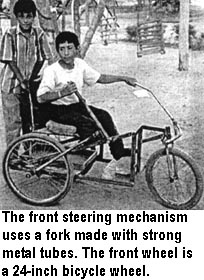

Examples of Different Tricycle Designs from Different Lands
|
Personal Transport for Disabled People - Design and Manufacture AHRTAG |
Asia-Pacific Disability Aids and Appliances Handbook, Part 1: Mobility Aids, 1982 ACROD / ICTA sub-commission |
ACTION ON DISABILITY AND DEVELOPMENT 23 Lower Keyford |
|
How to Make Basic Hospital Equipment Intermediate Technology Publications, Ltd. |
HANDICAP INTERNATIONAL ERAC |
Note: Some tricycles are powered with only one hand. Others are powered with both hands (in which case the steering mechanism and drive mechanism are usually on the same bar, attached to the front fork). Some have hand-powered drive pedals (handles) on both sides of the tricycle, so that when one of the rider's arms tires she can use the other. It is important to pick the design that best meets the needs of the particular user. Booklets exist on different designs of tricycle wheelchairs. Some examples are shown here. (Also see Resource List #2 at the end of this book, page 343.)
Worldwide Sharing of Tricycle Know-How, Coordinated by
APPROPRIATE MOBILITY INTERNATIONAL
Great progress is under way in terms of the sharing of knowledge about different designs of hand-powered tricycles. A world-wide information sharing network has been launched by a group called Appropriate Mobility International (AMI), based at Delft University of Technology, in Holland. Joep Verweij of AMI has collected information and photos on scores of tricycle designs from rich countries and poor, world-wide, He has assembled these in an Overview Report titled Inventory of Tricycle Models (see page 344). The wide diversity of design is a testimony to the creativity of disabled people and local craftspersons. Here are a few examples of this diversity, taken from the Inventory of Tricycle Models, and elsewhere:



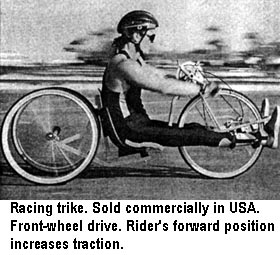
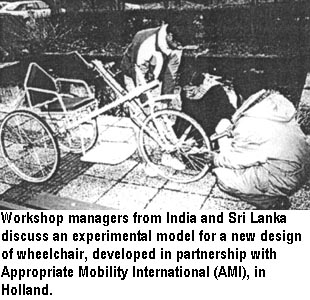

High-Tech Communications for Grass-Roots Shop Workers:
"Tricycle Production Manual," by the Folks at Appropriate Mobility International
Based on their research and the design perspectives of tricycle users and designers from all over the world, folks at AMI and the Center for International Cooperation and Appropriate Technology have put together a remarkable instruction manual. With hundreds of line drawings and very few words, the manual guides the reader through the steps of building an improved model of a hand-operated tricycle.

The Table of Contents of the Manual uses the pictures shown below to indicate headings:
- TRICYCLE
- PRODUCTION
- ADDITIONS
- MATERIALS
- INFORMATION

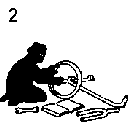

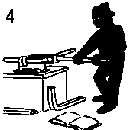


Research in preparation of the manual included a study of people's ability to interpret pictures. As a result, many of the drawings - which have been done with great precision with a computerized graphics program - are 3-dimensional, as shown right.
This innovative manual deserves careful study, not only by wheelchair builders, but by anyone interested in exploring new ways of communicating clearly. Through the use of step-by-step series' of computerized drawings, it attempts to bridge the gap between sophisticated technology and the traditional skills of local craftspersons, whose understanding tends to be based on real (or at least realistically drawn) objects rather than written words. (See Resource List #2, on page 344.)
A CONVERTIBLE TRICYCLE-WHEELCHAIR FOR ALEJANDRO
At the time this book went to press, Alejandro had been offered a scholarship to study English at the Academia de Ingles Golden Gate, in his home city of Mazatlan. (The Academy is run by a disabled youth, Jose Angel Tirado, whom PROJIMO assisted in his childhood. See page 315.) To get to the Academy on the rough, heavily trafficked roads, Alejandro could use the sturdy tricycle made for him at PROJIMO. But this outdoor vehicle was much too big to move about inside the Academy or to enter a classroom.
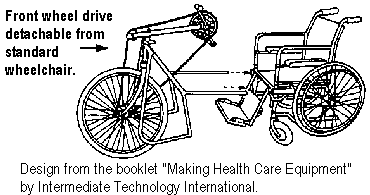
Therefore the PROJIMO team decided they should make a tricycle that Alejandro could quickly convert into an ordinary wheelchair for indoor use. Armando remembered seeing a design for such a tricycle in a booklet called Making Health Care Equipment (see page 343). It consisted of a standard wheelchair to which a tricycle front-end (including a large front wheel, hand pedals, and a steering mechanism) could be easily attached or removed.
Alejandro thought that such a trike would meet his needs. For long distance rides on rough roads, he could use the full tricycle. On arrival at the Academy (or at home) he could unplug the front section and enter the building in the compact wheelchair.
For this experimental model, Armando and Marcelo adapted a standard donated wheelchair. They used a 24-inch bicycle wheel at the front. They welded together a tube frame, with rods that could slip into the side tubes of the chair seat.


Need for improvements:
At the time of this writing, the experimental design had been built and tested, but still had problems. The chain that linked the hand crank to the front wheel occasionally jumped off the sprockets (which needed better alignment). Also, some sort of device or blocks were needed to hold the chair's caster wheels a couple of centimeters off the ground - so that Alejandro can plug in or remove the tricycle unit while sitting in the chair.
Tricycle designs must be adapted to local needs. In urban Mexico, a standard tricycle is too long to fit into buildings and classrooms. In rural Africa, a standard tricycle is too wide to ride on narrow dirt trails. An African boy's innovative solution is shown on the next page.
PAFUPI BUILDS HIS OWN TRICYCLE FOR NARROW TRAILS
PAFUPI lived in a remote village in Malawi, Africa. Because his legs were paralyzed by polio, he had started school later than most children. The school was too far away to walk to on his braces and crutches. He dreamed of having a hand-powered tricycle. But the trails where he lived were much too narrow for the big, wide tricycles made in the cities.
Pafupi was good with his hands and had an inventive streak. As a child he had made a guitar from old tin cans and scraps of leather. And he had learned to play it fairly well.
When he was 17, Pafupi decided to make a small tricycle that was narrow enough to ride on local trails. He used parts of 3 old bicycles, an old flywheel, and bits of scrap metal. He had no welding equipment. So he hammered the ends of the pieces together precisely, like interlocking fingers. Although the joints were slightly flexible, they were remarkably strong.


On his way home from school, Pafupi rides his improved "narrow gauge" tricycle, designed for the narrow trails. (See Left)
The tools Pafupi used to make his tricycle were very basic: a small block of iron which he used as an anvil, 2 hammers, and a piece of an old hack-saw blade held in a curved metal pipe. (See Right)
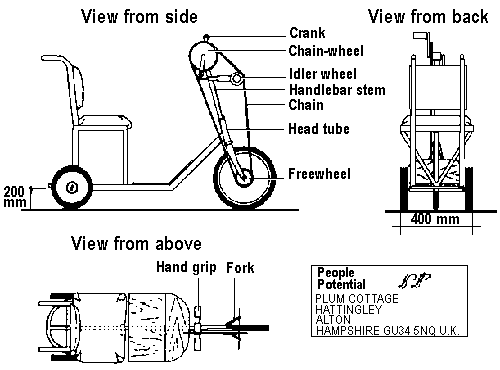
On a trip to Malawi, Kennett Westmacott, an innovator of disability aids, saw Pafupi on his home-made tricycle. (In England, Kennett and his wife, Jean, run People Potential, where they teach ordinary people to design and make simple assistive devices. See pages 72 and 74). Fascinated by the appropriateness of Pafupi's home-made tricycle, Kennett and his students tried to build one like it in a training workshop. But their modified version had problems. To get it to work well, the group had to rebuild the tricycle, closely following Pafupi's design. Then they modified it with a bigger front wheel and other helpful changes.
An outstanding feature of Pafupi's tricycle was that he could pedal it in reverse (make it back up), something Kennett had not seen before in small, chain-driven tricycles.
The group was amazed that Pafupi - a viliage boy in primary school - was able to create such a well-adapted and functional vehicle, all done with very simple tools and without welding. Their respect for the skill and creativity of disabled villagers increased greatly.
Nothing About Us Without Us
Developing Innovative Technologies
For, By and With Disabled Persons
by David Werner
Published by
HealthWrights
Workgroup for People's Health and Rights
Post Office Box 1344
Palo Alto, CA 94302, USA





